Vimar ELVOX 1234 Handleiding
Vimar
Niet gecategoriseerd
ELVOX 1234
Bekijk gratis de handleiding van Vimar ELVOX 1234 (28 pagina’s), behorend tot de categorie Niet gecategoriseerd. Deze gids werd als nuttig beoordeeld door 187 mensen en kreeg gemiddeld 4.4 sterren uit 94 reviews. Heb je een vraag over Vimar ELVOX 1234 of wil je andere gebruikers van dit product iets vragen? Stel een vraag
Pagina 1/28

1200
Targhe citofoniche/videocitofoniche Serie 1200
1200 Series interphone/video door entry system entrance panels
Platines parlophoniques/visiophoniques Série 1200
Haustelefon-/Videohaustelefon-Klingeltableaus Serie 1200
Placas para portero automático/videoportero serie 1200
Botoneiras para porteiro automático/videoporteiro série 1200
Μπουτονιέρων θυροτηλέφωνου/θυροτηλεόρασης σειράς 1200
Manuale installatore - Installer guide
Manuel installateur - Technisches Handbuch
Instrucciones instalador - Manual do instalador
Εγχειρίδιο οδηγιών

Caratteristiche tecniche
Targhe serie 1200:
• Placca in acciaio inox aisi 316 (4VA) di spessore 8/10, con
superficie goffrata (acciaio inox) o con trattamento in PVD
(effetto oro)
• Installabili da incasso o da parete con relativi accessori
• Grado di protezione contro gli impatti IK10 (ad eccezione
delle placche Audio/Video per unità elettronica alfanume-
rica e relative placche supplementari con cartelli portanomi
per unità elettronica alfanumerica).
• Grado di protezione IP44
• Testate in pressofusione di alluminio (che consentono un
fissaggio del frontale al telaio per mezzo di una vite spe-
ciale ELVOX)
• Supporto per i tasti in policarbonato antiurto trasparente
• Telaio in acciaio inox.
• Tasti in policarbonato trasparente ricoperti con una prote-
zione in acciaio inox
Targhe serie 1200 rinforzate:
• Placca in acciaio inox aisi 316 (4VA) di spessore 8/10, con
trattamento di vernice satinata (grigio sablé) resistente agli
agenti atmosferici e per installazioni in ambienti salini.
• Installabili da incasso con relativi accessori
• Grado di protezione contro gli impatti IK10 (ad eccezione
delle placche Audio/Video per unità elettronica alfanume-
rica e relative placche supplementari con cartelli portanomi
per unità elettronica alfanumerica).
• Grado di protezione IP44
• Testate in pressofusione di alluminio (che consentono un
fissaggio del frontale al telaio per mezzo di una vite spe-
ciale ELVOX)
• Supporto per i tasti in policarbonato antiurto trasparente
• Telaio in acciaio inox.
• Tasti in policarbonato trasparente ricoperti con una prote-
zione in acciaio inox
Gli elementi della serie 1200 permettono la composizione
di targhe per impianti citofonici e videocitofonici con tec-
nologia:
- Due Fili Elvox
- Digibus
- Chiamata Sound System o c.a.
Le targhe sono fornite di placca frontale e telaio e sono da
completare con l’elettronica e relativi componenti aggiuntivi
forniti separatamente da scegliere in funzione del tipo di im-
pianto ( ue Fili Elvox, Digibus, Sound System, chiamata c.a.) D
e il tipo di installazione.
L’istruzione si riferisce al solo montaggio della targa.
Per l’intallazione completa, il collegamento e la programma-
zione (per targhe elettroniche), fare riferimento al manuale
dell’unità elettronica, telecamera o posto esterno da inserire:
Per sistema DUE FILI:
- Unità elettronica a pulsanti: 13F3 (audio), 13F5 (video)
- Unità elettronica con tastiera alfanumerica: 13F4
(audio), 13F7 (video)
- Posto esterno audio: 6931.
Per sistema DIGIBUS:
- Unità elettronica a pulsanti: 1283 (audio), 1285 (video)
- Unità elettronica con tastiera alfanumerica: 1282 (audio),
1286 (video)
Per sistema o Sound System C.A.:
- Posti esterni audio: Art. 930A, 930C, 930D, 930F, 930G.
- Telecamera con Posto esterno: Art. 559A, 559B, 560A.
Componenti aggiuntivi per impianti Due Fili e Di-
gibus
La targa viene fornita con la predisposizione per impianti vi-
deocitofonici, è da implementare con i seguenti articoli:
- Scatola da incasso parete art. 9192 per targhe in 2 moduli
verticali oppure art. 9193 per targhe in 3 moduli verticali.
Nota: Le scatole 9192 o 9193 non possono essere combi-
nate tra loro ma solo tra: 9192 con 9192 oppure 9193 con
9193.
- Cornici parapioggia art. 1P21, 1P22, 1P23, 1P24 per tar-
ghe su 2 moduli verticali oppure 1P31, 1P32, 1P33, 1P34
per targhe su 3 moduli verticali
- Scatole da esterno con parapioggia art. 1E21, 1E22,
1E23, 1E24 per taghe in 2 moduli verticali oppure 1E31,
1E32, 1E33, 1E34 per targhe in 3 moduli verticali.
- Unità elettronica audio a pulsanti Art. 13F3 (Due Fili) o Art.
1283 (Digibus)
- Unità elettronica audio alfanumerica Art. 13F4 (Due Fili) o
Art. 1282 (Digibus)
- Unità elettronica video a pulsanti Art. 13F5 (Due Fili) o Art.
IT
Il manuale istruzioni è scaricabile dal sito www.vimar.com 1285 (Digibus)
- Unità elettronica video alfanumerica Art. 13F7 (Due Fili) o
Art. 1286 (Digibus)
- Modulo supplementare a pulsanti: Art. 12TS con 4 pulsanti
(per targhe con tasti in fila singola) o Art. 12TD con 8
pulsanti (per targhe con tasti in doppia fila)
E’ possibile predisporre la medesima targa per unità elettro-
nica audio in questo caso si deve togliere l’anello dal retro
della placca frontale, evidenziato con numero 1 in figura 6,
inserire al suo posto la mascherina di chiusura obiettivo, evi-
denziata con numero 2 di figura 6, sul telaio (B).
Componenti aggiuntivi per impianti con chiamata
Sound System o in c.a.
La targa viene fornita con la predisposizione per impianti vi-
deocitofonici, è da implementare con i seguenti articoli:
- Scatola da incasso parete art. 9192 per targhe in 2 moduli
verticali oppure art. 9193 per targhe in 3 moduli verticali.
Nota: Le scatole 9192 o 9193 non possono essere combi-
nate tra loro ma solo tra: 9192 con 9192 oppure 9193 con
9193.
- Telecamera con posto esterno art. 559A o 559B o 560A o
posto esterno Art. 930A, 930B, 930C, 930D, 930F o Art.
930G (la figura 1 illustra come inserire la telecamera sul
telaio)
- Pulsanti art. R200 o R200/50 (R200/50 = confezione con
50 pulsanti R200)
- LED per illuminazione cartellini portanomi art. R260
- Diodi art. 0002/994 (per impianti “unifilari 1+N” o senza
cavo coassiale).
- Cornici parapioggia art. 1P21, 1P22, 1P23, 1P24 per tar-
ghe su 2 moduli verticali oppure 1P31, 1P32, 1P33, 1P34
per targhe su 3 moduli verticali
- Scatole da esterno con parapioggia art. 1E21, 1E22,
1E23, 1E24 per taghe in 2 moduli verticali oppure 1E31,
1E32, 1E33, 1E34 per targhe in 3 moduli verticali.
E’ possibile predisporre la medesima targa per il solo posto
esterno audio in questo caso si deve togliere l’anello dal retro
della placca frontale, evidenziato con numero 1 in figura 6,
inserire al suo posto la mascherina di chiusura obiettivo, evi-
denziata con numero 2 di figura 6, sul telaio ( ), installare B
con le viti in dotazione la staffetta ( ) per posto esterno audio, C
(vedi figura 20, 22, 24).
Installazione delle targhe serie 1200 in si-
stemi Due Fili o Digibus.
- Installare a muro la scatola da incasso o la scatola da (N)
esterno parete ad una altezza di circa 1,65m dal bordo (P)
superiore della scatola al pavimento.
Nota: Le targhe della serie 1200 possono essere ampliate
solo in senso orizzontale con targhe supplementari. Nel
caso di installazione da incasso le scatole vanno abbinate
per mezzo degli appositi agganci forniti con le scatole
stesse (vedi fig. 30).
- Fissare la morsettiera dell’unità elettronica sotto il telaio
portamoduli, per mezzo delle viti in dotazione.
- Nel caso di installazione da incasso parete:
- Fissare l’eventuale cornice parapioggia alla scatola (O)
da incasso (N).
- Fissare il telaio alla scatola da incasso o alla cor(B) (N) -
nice parapioggia.
Nel caso di installazione da esterno parete:
- Fissare il telaio alla scatola da esterno.(B)
- Collegare la morsettiera dell’unità elettronica all’impianto,
seguendo gli schemi di collegamento nel manuale di rife-
rimento a seconda della tipo di impianto.
- Collegare l’unità elettronica alla morsettiera per (S, T/U, V)
mezzo del cablaggio presente nel lato superiore.
- Collegare gli eventuali moduli supplementari (fig. 31B,
31C). Si collegano uno di seguito all’altro per mezzo dei
cablaggi forniti con i moduli e si collegheranno infine all’u-
nità elettronica base tramite il cablaggio presente nel lato
inferiore della stessa.
Il collegamento di più moduli supplementari può ri-
chiedere un alimentatore supplementare art. 6582 per
l’alimentazione dei LED di illuminazione cartellini.
- Inserire l’unità elettronica e gli eventuali moduli supple-
mentari nei telai (per i moduli supplementari Art. 12TS di
targhe a pulsanti, utilizzare l’intramezzo fornito in dota-
zione per mantenerli uniti, vedi Fig. 31B).
- Inserire il microfono nell’apposita sede posta sul telaio (B)
nel lato inferiore destro, richiudendo il tappo, come indi-
cato nella fig. 7 part. 1.
Nota: Nelle unità elettroniche per sistemi Digibus e neces-
sario sfilare o tagliare il tappo in gomma (preesistente nei
posti esterni audio o telecamere) facendo attenzione a non
tagliare i cavi del microfono (vedi fig.7).
- Eseguire le fasi di programmazione, facendo riferimento al
manuale dell’unità elettronica.
- Nel caso di impianto citofonico sul retro della placca fron-
tale si deve: togliere l’anello per obiettivo e inserire la (E)
mascherina di chiusura obiettivo (vedi fig. 6).(D)
- Chiudere la targa fissandola al telaio per mezzo della chia
-
vetta speciale fornita in dotazione (vedi fig. 8).“P”
Installazione delle targhe serie 1200 in si-
stemi con posto esterno audio o telecamera
con posto esterno (sistemi Sound System
o c.a)
Installazione delle targhe da incasso parete
- Installare a muro la scatola da incasso ad una altezza (N)
di circa 1,65m dal bordo superiore dalla scatola al pavi-
mento
Nota: Le targhe della serie 1200 possono essere am
-
pliate solo in senso orizzontale con targhe supplementari,
unendo le scatole da incasso per mezzo degli appositi ag-
ganci forniti con le scatole (vedi fig. 30).
- Nel caso di impianto citofonico: fissare la staffetta nella (C)
parte alta del telaio per mezzo delle viti, nei fori predi(B) -
sposti e fissare il posto esterno alla staffetta (vedi fig.20,
22)
- Nel caso di impianto videocitofonico: fissare la telecamera
(M) al telaio come indicato nelle fig. 1, 21, 23 (B)
- Inserire il microfono nell’apposita sede posta sul telaio (B)
richiudendo il tappo come indicato nella fig. 7 part. 1.
- Fissare i pulsanti al telaio come indicato nelle fig. (G) (B)
20, 21, 22, 23
- Fissare la scheda per illuminazione a LED nell’appo (H) -
sita sede come indicato nelle fig. 20, 21, 22, 23
- Fissare l’eventuale cornice parapioggia alla scatola da (O)
incasso
- Fissare il telaio alla scatola da incasso o alla cornice para-
pioggia
- Nel caso di impianto citofonico sul retro della placca fron-
tale si deve: togliere l’anello per obiettivo e inserire la “E”
mascherina di chiusura obiettivo (vedi fig. 6)“D”
- Collegare il posto esterno o la telecamera, i pulsanti e la
scheda LED all’impianto, seguendo gli schemi di collega-
mento nel manuale di riferimento a seconda della tipo di
impianto.
- Chiudere la targa fissandola al telaio per mezzo di un cac-
ciavite (vedi fig. 8).
Installazione delle targhe da esterno parete
- Installare a muro la scatola da esterno parete ad una (P)
altezza di circa 1,65m dal bordo superiore della scatola al
pavimento.
Nota: Le targhe della serie 1200 possono essere ampliate
solo in senso orizzontale con targhe supplementari.
- Nel caso di impianto citofonico: fissare la staffetta (C) nella
parte alta del telaio per mezzo delle viti, nei fori predi(B) -
sposti e fissare il posto esterno alla staffetta (vedi fig. 24)
- Nel caso di impianto videocitofonico: fissare la telecamera
(M) (B)al telaio come indicato in fig. 1, 25.
- Inserire il microfono nell’apposita sede posta sul telaio (B)
richiudendo il tappo come indicato nella fig. 7 part. 1.
- Fissare il telaio alla scatola da esterno
- Fissare la scheda per illuminazione a LED nell’appo (H) -
sita sede come indicato nelle fig. 24, 25
- Nel caso di targa con solo posto esterno audio sul retro
della placca frontale si deve: togliere l’anello per obiettivo
“E” “D” e inserire la mascherina di chiusura obiettivo
(vedi fig. 6)
- Collegare il posto esterno o la telecamera, i pulsanti e la
scheda LED all’impianto, seguendo gli schemi di collega-
mento nel manuale di riferimento a seconda della tipo di
impianto.
- Chiudere la targa fissandola al telaio per mezzo della chia-
vetta speciale fornita in dotazione (vedi fig. 8).“P”
2
1200

EN
The instruction manual is downloadable from the site
www.vimar.com
Technical specications
1200 Series Entrance Panels:
• Cover plate made of AISI 316 stainless steel (4VA) 8/10
thick, with embossed surface (stainless steel) or with PVD
treatment (gold effect)
• Can be wall-mounted or ush-mounted with relevant ac-
cessories
• IK10-rated for protection against impact (except for Audio/
Video cover plates for alphanumeric electronic units and
related additional plates with name cards for alphanumer-
ic electronic units).
• Protection class: IP44
• Die-cast aluminium heads (that enable fixing the front plate
to the frame with a special ELVOX screw)
• Support for transparent shockproof polycarbonate buttons
• Stainless steel frame.
• Transparent polycarbonate buttons covered with stainless
steel protection
Reinforced 1200 Series Entrance Panels:
• Cover plate made of AISI 316 stainless steel (4VA) 8/10
thick, with weatherproof satin nish (sable grey) paint
treatment also for installation in saline environments.
• Can be ush-mounted with relevant accessories
• IK10-rated for protection against impact (except for Audio/
Video cover plates for alphanumeric electronic units and
related additional plates with name cards for alphanumer-
ic electronic units).
• Protection class: IP44
• Die-cast aluminium heads (that enable fixing the front plate
to the frame with a special ELVOX screw)
• Support for transparent shockproof polycarbonate buttons
• Stainless steel frame.
• Transparent polycarbonate buttons covered with stainless
steel protection
The items in the 1200 series enable making entrance
panels for audio and video door entry systems with the
technology of:
- Elvox Due Fili
- Digibus
- Sound System or C.A. call
The entrance panels are supplied with a front plate and a
frame and are comprehensive of electronics and related add-
ons supplied separately to be selected depending on the type
of plant (Elvox ue Fili, Digibus, Sound System, c.a. call) and D
the type of installation.
The instructions refer to mounting the entrance panel only.
For complete installation, connection and programming (for
electronic panels), please refer to the manual of the electronic
unit, camera or speech unit to be added:
For the DUE FILI system:
- Push-button electronic unit: 13F3 (audio), 13F5 (video)
- Electronic unit with alphanumeric keypad: 13F4 (audio),
13F7 (video)
- Audio speech unit: 6931.
For the DIGIBUS system:
- Push-button electronic unit: 1283 (audio), 1285 (video)
- Electronic unit with alphanumeric keypad: 1282 (audio),
1286 (video)
For the or . system: Sound System C.A
- Audio speech units: Art. 930A, 930C, 930D, 930F, 930G.
- Camera with Speech Unit: Art. 559A, 559B, 560A.
Additional components for Due Fili and Digibus
systems
The entrance panel is supplied ready for video door entry
systems and is to be implemented with the following items:
- Flush-mounted back box art. 9192 for entrance panels in
2 vertical modules or art. 9193 for entrance panels in 3
vertical modules.
Note: Back boxes 9192 and 9193 cannot be matched with
each other but only as follows: 9192 with 9192 or 9193
with 9193.
- Rainproof covers art. 1P21, 1P22, 1P23, 1P24 for en-
trance panels in 2 vertical modules or 1P31, 1P32, 1P33,
1P34 for entrance panels in 3 vertical modules
- Surface-mounted boxes with rainproof cover art. 1E21,
1E22, 1E23, 1E24 for entrance panels in 2 vertical mod-
ules or 1E31, 1E32, 1E33, 1E34 for entrance panels in 3
vertical modules.
- Push-button audio electronic unit Art. 13F3 (Due Fili) or
Art. 1283 (Digibus)
- Alphanumeric audio electronic unit Art. 13F4 (Due Fili) or
Art. 1282 (Digibus)
- Push-button video electronic unit Art. 13F5 (Due Fili) or
Art. 1285 (Digibus)
- Alphanumeric video electronic unit Art. 13F7 (Due Fili) or
Art. 1286 (Digibus)
- Additional module with buttons: Art. 12TS with 4 buttons
(for entrance panels with a single row of keys) or Art. 12TD
with 8 buttons (for entrance panels with two rows of keys).
The same entrance panel can be preset for the audio elec-
tronic unit, in which case you need to remove the ring from
the back of the front plate, marked with number 1 in figure 6,
and in its place insert the cover for closing the lens, marked
with number 2 in figure 6, on the frame (B).
Additional components for Sound System and
C.A. call systems:
The entrance panel is preset for video entrance panel sys-
tems and is to be implemented with the following articles:
- Flush-mounted back box type 9192 for entrance panels in
2 vertical modules or type 9193 for entrance panels in 3
vertical modules.
Note: Back boxes type 9192 or 9193 cannot be matched
between them but only between: 9192 with 9192 or 9193
with 9193
- Video camera with speech unit type 559A or 559B or 560A
or speech unit type 930A, 930B, 930C, 930D, 930F or Art.
930G (fig. 1 shows how to insert the camera in the frame).
- Push-buttons type R200, R200/50 (R200/50 = package
with 50 push-buttons R200)
- LED for lighting name-tags type R260
- Diodes type 0002/994 (for “1+N wires” or without coaxial
cable).
- Rainproof covers type 1P21, 1P22, 1P23, 1P24 for en-
trance panels in 2 vertical modules or 1P31, 1P32, 1P33,
1P34 for entrance panels in 3 vertical modules
- Surface-mounted boxes with rainproof cover type 1E21,
1E22, 1E23, 1E24 for entrance panels in 2 vertical mod-
ules or 1E31, 1E32, 1E33, 1E34 for entrance panels in 3
vertical modules.
The same entrance panel can be preset for the sole external
speech unit; in this case remove the ring from the back of the
front plate (identified with number 1 in fig. 6); insert in its place
the cover for closing the lens (shown with number 2 in fig. 6)
in the frame “ ”, install the bracket “ ” (using the screws supB C -
plied) for the speech unit (see fig. 20, 22, 24).
Installing 1200 series panels in Due Fili or
Digibus systems.
- Install the flush-mounting back box or the surface-(N)
mounting back box on the wall at a height of approx. (P)
1.65m from the top edge of the box to the ground.
Note: The 1200 series panels can be expanded only hori-
zontally with supplementary entrance panels. In the case
of flush-mounting, the boxes are to be coupled using the
hooks supplied with the boxes (see Fig. 30).
- Secure the terminal block of the electronic unit under the
module holder frame with the screws provided.
- When flush-mounting on a wall:
- Secure the rainproof cover if applicable, to the flush-(O),
mounting box (N).
- Secure the frame to the flush-mounting box or to (B) (N)
the rainproof cover.
When surface-mounting on a wall:
- Secure the frame (B) to the surface-mounting back
box.
- Connect the terminal block of the electronic unit to the sys-
tem, following the wiring diagrams in the reference manual
depending on the type of system.
- Connect the electronic unit to the terminal block (S, T/U, V)
with the wiring in the top.
- Connect any additional modules used (fig. 31B, 31C).
They should be connected one after the other by means of
the wiring supplied with the modules, and finally connected
to the standard electronic unit by means of the wiring in its
lower section.
The connection of more than one additional module
may necessitate the use of an additional power supply
unit art. 6582 to power the LEDs lighting the signs.
- Insert the electronic unit and any additional modules in
the frames (for the additional modules Art. 12TS of push-
button entrance panels, use the insert supplied to hold
them together, see Fig. 31B).
- Insert the microphone into the seat over the frame in (B)
the lower right side, closing the cap, as shown in fig. 7
detail 1.
Note: On the electronic units for Digibus systems it is nec-
essary to take out or cut the rubber cap (existing on audio
speech units or cameras), taking care not to cut the wires
of the microphone (see fig.7).
- Do the programming, referring to the manual of the elec-
tronic unit.
- For audio door entry systems, on the back of the front plate
you need to take out the lens ring and insert the cover (E)
for closing the lens (see fig. 6).(D)
- Shut the entrance panel, fixing it to the frame using the
special key “P” supplied (see fig. 8).
Installing the 1200 series panels in systems
with an audio speech unit or camera with a
speech unit (Sound System or c.a. systems)
Installing flush-mounting entrance panels on a
wall
- Install the flush-mounting back box on the wall at a (N)
height of approx. 1.65m from the top edge of the box to
the ground
Note: The 1200 series panels can be expanded only hori
-
zontally with additional panels, joining the flush-mounting
back boxes with the hooks supplied with the boxes (see
Fig. 30).
- In the case of audio door entry systems: secure the
bracket (C) at the top of the frame (B) with the screws in
the ready-made holes and secure the speech unit to the
bracket (see fig.20, 22)
- In the case of video door entry systems: secure the cam-
era (M) to the frame as shown in fig. 1, 21, 23 (B)
- Insert the microphone into the seat over the frame (B)
closing the cap, as shown in fig. 7 detail 1.
- Secure the push-buttons to the frame as shown in (G) (B)
fig. 20, 21, 22, 23
- Secure the card for LED lighting in its seat as shown in (H)
fig. 20, 21, 22, 23
- Secure the rainproof cover to the flush-mounting box(O)
- Secure the frame to the flush-mounting box or to the rain-
proof cover
- For audio door entry systems, on the back of the front plate
you need to take out the lens ring and insert the cover “E”
for closing the lens (see fig. 6)“D”
- Connect the speech unit or the camera, push-buttons and
LED card to the system, following the wiring diagrams in
the reference manual depending on the type of system.
- Close the entrance panel, securing it to the frame with the
aid of a screwdriver (see fig. 8).
Installing surface-mounting entrance panels on
a wall
- Install the surface-mounting back box on the wall at a (P)
height of approx. 1.65m from the top edge of the box to the
ground.
Note: The 1200 series panels can be expanded only hori
-
zontally with supplementary entrance panels.
- In the case of audio door entry systems: secure the
bracket (C) at the top of the frame (B) with the screws in
the ready-made holes and secure the speech unit to the
bracket (see fig. 24)
- In the case of video door entry systems: secure the cam-
era (M) to the frame as shown in fig. 1, 25. (B)
- Insert the microphone into the seat over the frame (B)
closing the cap, as shown in fig. 7 detail 1.
- Secure the frame to the surface-mounting back box
- Secure the card for LED lighting in its seat as shown in (H)
fig. 24, 25
- For entrance panels with only an audio speech unit, on the
back of the front plate you need to take out the lens ring
“E” “D” and insert the cover for closing the lens (see fig.
6)
- Connect the speech unit or the camera, push-buttons and
LED card to the system, following the wiring diagrams in
the reference manual depending on the type of system.
- Shut the entrance panel, fixing it to the frame using the
special key “P” supplied (see fig. 8).
3
1200
Product specificaties
| Merk: | Vimar |
| Categorie: | Niet gecategoriseerd |
| Model: | ELVOX 1234 |
Heb je hulp nodig?
Als je hulp nodig hebt met Vimar ELVOX 1234 stel dan hieronder een vraag en andere gebruikers zullen je antwoorden
Handleiding Niet gecategoriseerd Vimar
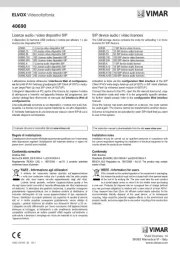
2 September 2025
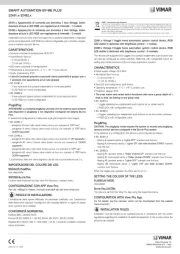
26 Augustus 2025
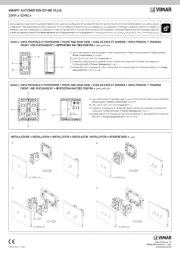
26 Augustus 2025
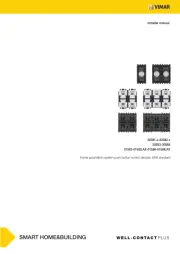
26 Augustus 2025
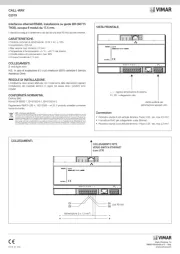
14 Augustus 2025
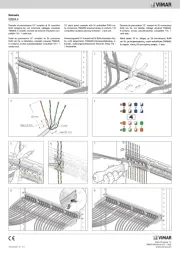
5 Juli 2025
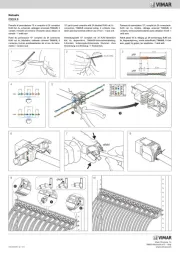
5 Juli 2025
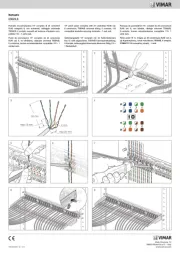
5 Juli 2025

5 Juli 2025
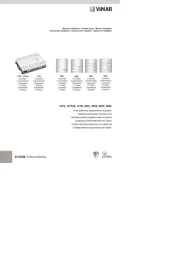
24 Mei 2025
Handleiding Niet gecategoriseerd
- OneTouch
- Ronco
- Dunlop
- Taga Harmony
- USL
- Cort
- Itho-Daalderop
- CRB Cleaning Systems
- Qian
- Kingston Technology
- Maglite
- Ibiza Sound
- Das Keyboard
- Shimano
- Cioks
Nieuwste handleidingen voor Niet gecategoriseerd

14 September 2025

14 September 2025

13 September 2025

13 September 2025

13 September 2025

13 September 2025

13 September 2025

13 September 2025

13 September 2025

13 September 2025